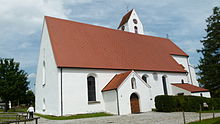Vicarage Maria Rain
The vicarage Maria Rain is a listed building in Maria Rain in the Oberallgäu district in the Bavarian administrative district of Swabia . The farm is in the immediate vicinity of the oldest pilgrimage church in the Allgäu.
history
The construction of today's pilgrimage church was approved in 1496 by the Augsburg bishop Friedrich II von Zollern . This was preceded by a donation from Cardinal Peter von Schaumberg , also Bishop of Augsburg , in 1439. In 1648, the nave was vaulted out of gratitude for peace. At the beginning of the 18th century the Gothic windows were replaced by arched windows. New furnishings come into the church ( scapular altar by Nikolaus Babel , the altarpiece of St. Hyacinth by Paul Zeiller ). After the Thirty Years' War, the Marian pilgrimage flourished again. During this time, today's rectory was built. It stands in the immediate vicinity of the church and together with it forms an architectural ensemble.
As early as 1443, Hans Bach from Wertach mentions the purchase of a widum property including a house near the church . In 1439 Cardinal Peter appointed him the first chaplain of the "Wertach-Rain". At St. Laurentius in 1443 he bought the house and field from Peter Hensel from Buchen for 81 pounds Heller . On the lower floor of today's rectory, there are still remnants of the building that Hans Bach bought. His successor, Dr. Ulrich Bach from Wertach, bought the house and farm and all fields from Heinz Schaul zu Buchen to Martini in 1458 for 37 pounds Heller and on Bruno Day 1463 he bought the estate from Hans Zimmermann zu Guggenmoos, which had become the benefit of Maria Rain because of excessive indebtedness . This property was sold again in 1648 because the house burned down during the Swedish War.
construction
In 1720, the current rectory was built by master builder Mathäus Roth in place of the old building. The outside of the block building is completely clad with shingles . Cornices were attached to the windows and the front door was artistically designed (in the style of the Renaissance?). The agricultural building (stable, threshing floor and hooked head ) was only added in 1870 . In 1975 the dilapidated roof was renovated and the roof structure stabilized. In the western part of the building, the parish hall has been housed since 1998 with the parish hall and rooms for the local associations.
The condition of the building has deteriorated significantly since the last construction work. On May 24th, 2009 an “Association for the Preservation of the Old Rectory in Maria Rain” was founded, which in 2012 has over 50 members.
Residents
Of the beneficiaries who followed the two Bach's, only a few names can be listed up to 1630. Pastor Weißkopf from Mittelberg was a pastor in Maria Rain from 1630 to 1636, then Father Sylvan Herzog from the Ottobeuren monastery . He was followed by the brother of Abbot Gregor Reubi from Ottobeuren, the beneficiary Father Aemilian Reubi. He exchanged with the Hindelang pastor Kaspar Scholl.
In 1660, Balthasar Kirchmayer, who established the Scapular Brotherhood , took over. He enlarged the Widumgut until 1707 by purchasing land and grazing rights. His successor Balthasar Rietzler from Oberstdorf changed the altars in 1707 as they are today. After 39 years he was followed by beneficiaries Seifried and Hindelang. After the death of the beneficiary Alois Zweng, the residents of Maria Rain campaigned for the establishment of their own parish and after five years of dispute, the survey on the parish expositur was published on May 30, 1830. The first pastor was Sebastian Schmid from Scheidegg . Maria Rain became an independent parish in 1852 under Pastor Joseph Spiegele. Other residents of the rectory are documented as Alexander Gerstbacher from Linsen (1872–1879), Joseph Schelbert from Sigishofen (1879–1887), who was also a farmer and member of the Reichstag, Johann B. Karg from Kempten (1887–1915), and Franz Xaver Kugelmann from Weiler (1915–1930), Otto Schmid from Immenstadt (1930–1938), Karl Kotter from Donauwörth (1938–1940), Friedrich Heine (1940–1953), Alois Roßmanith from Olmütz in the Sudetenland (1953–1964) and most recently Friedrich Rosenberger from Innsbruck (1965–1990).
The rectory has been empty since 1990.
Individual evidence
- ↑ List of monuments for Oy-Mittelberg (PDF; 563 kB) at the Bavarian State Office for Monument Preservation, accessed on July 29, 2012
literature
- The parish and pilgrimage church in Maria Rain - an eventful past . In: Calendar for the Christian People 1879. “Our home supplement” No. 9, pp. 2 and 3
- Aegidius Kolb, Ewald Kohler (ed.): The rural people of the Allgäu in their doings and activities by Joseph Schelbert (1834–1887) , Allgäuer Zeitungsverlag Kempten. ISBN 3-88006-088-6
Coordinates: 47 ° 38 ′ 14.2 " N , 10 ° 29 ′ 54.2" E



